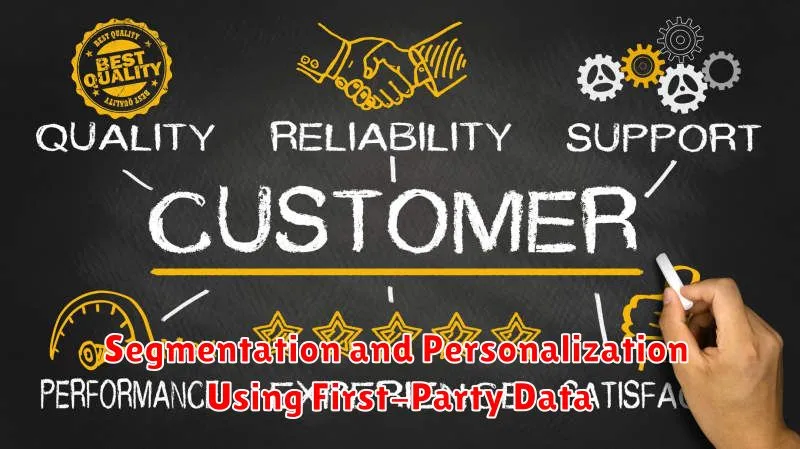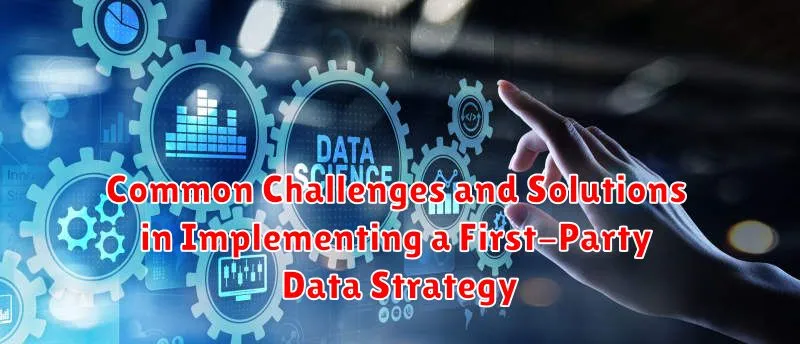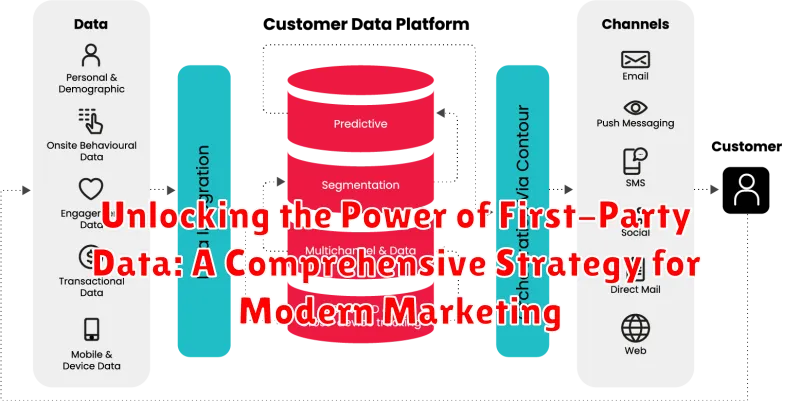In today’s rapidly evolving digital landscape, businesses are constantly seeking innovative strategies to enhance their marketing efforts and drive sustainable growth. One of the most powerful and often underutilized assets is first-party data. This article, “Unlocking the Power of First-Party Data: A Comprehensive Strategy for Modern Marketing,” delves into the significance of leveraging the information your organization directly collects from its customers. From improving customer engagement and personalization to optimizing marketing campaigns and ensuring data privacy compliance, understanding and effectively utilizing first-party data is now paramount for success in the modern marketing arena.
This comprehensive guide provides a step-by-step approach to building a robust first-party data strategy. We will explore the fundamental concepts, including what constitutes first-party data, its advantages over third-party data, and the critical role it plays in building stronger customer relationships. Learn how to ethically collect, manage, analyze, and activate your data to gain valuable insights into customer behavior, preferences, and needs. Discover practical strategies for segmenting your audience, personalizing your messaging, and measuring the impact of your first-party data initiatives, ultimately leading to improved marketing ROI and enhanced customer loyalty.
What is First-Party Data and Why Does It Matter?
First-party data is information collected directly from your audience or customers. This data is gathered through sources your company owns and controls, such as your website, mobile app, CRM, email lists, surveys, and customer interactions. Unlike third-party data, which is purchased from external sources, first-party data provides a direct and often more reliable understanding of your customer base.
Why is it so important? In an increasingly privacy-conscious world, first-party data offers several critical advantages:
- Enhanced Data Quality: It’s accurate and relevant because it comes directly from your customers.
- Improved Customer Understanding: Gain deeper insights into customer behaviors, preferences, and needs.
- Personalized Experiences: Enables highly targeted and relevant marketing campaigns.
- Data Privacy Compliance: Because you collect the data, you control how it’s used, simplifying compliance with privacy regulations like GDPR and CCPA.
- Sustainable Marketing Strategy: Reduces reliance on third-party cookies, ensuring a more resilient and future-proof marketing approach.
The Benefits of Leveraging a First-Party Data Strategy
Leveraging a first-party data strategy offers numerous advantages for modern marketers. Primarily, it provides a more accurate and reliable understanding of your customer base compared to relying solely on third-party data.
Enhanced Customer Understanding: First-party data allows you to gain direct insights into customer behaviors, preferences, and needs, leading to more effective marketing campaigns.
Improved Personalization: By understanding your customers better, you can tailor your messaging and offers to resonate with them on a personal level, improving engagement and conversion rates.
Increased ROI: More targeted and relevant marketing efforts driven by first-party data translate into a higher return on investment (ROI).
Greater Data Control and Security: Owning your data gives you greater control over its management, security, and compliance with privacy regulations.
Stronger Customer Relationships: By demonstrating that you understand and value your customers, you can foster stronger relationships and build brand loyalty.
Building Your First-Party Data Collection Infrastructure
Establishing a robust infrastructure for collecting first-party data is crucial for successful marketing campaigns. This involves strategically implementing various tools and methodologies to gather data directly from your audience.
Key Components of the Infrastructure
- Website Tracking: Utilize tools like Google Analytics or dedicated customer data platforms (CDPs) to track user behavior on your website, including page views, clicks, and conversions.
- CRM Integration: Connect your website and marketing platforms with your CRM system to centralize customer data and create a unified view.
- Email Marketing Platforms: Employ email marketing platforms to capture subscriber information and track email engagement metrics.
- Social Media Engagement: Leverage social media platforms to collect data through surveys, polls, and contests.
- Customer Surveys and Feedback Forms: Implement surveys and feedback forms on your website or app to directly solicit customer opinions and preferences.
Prioritize data quality during collection. Implement validation checks and standardization processes to ensure accuracy and consistency across all data sources.
Segmentation and Personalization Using First-Party Data

First-party data empowers marketers to create highly targeted and personalized experiences. Segmentation involves dividing your audience into groups based on shared characteristics derived from your first-party data. This allows for tailored messaging and offers.
Examples of segmentation criteria include:
- Demographics: Age, gender, location
- Purchase History: Products bought, frequency, value
- Website Behavior: Pages visited, time spent, content engagement
- Email Engagement: Open rates, click-through rates
- Customer Lifetime Value: Predicted or actual value to the business
Personalization goes a step further by delivering unique experiences to individual customers. Using insights from your segments, you can personalize website content, email campaigns, product recommendations, and more. This increases engagement, improves conversion rates, and fosters stronger customer relationships. The effective use of first-party data ensures that personalization efforts are relevant and valuable to the customer, enhancing their overall experience with your brand.
Integrating First-Party Data with Your Marketing Technology Stack
Seamless integration of first-party data into your existing marketing technology (martech) stack is crucial for maximizing its value. This involves connecting your data sources with platforms like CRM systems, marketing automation tools, analytics platforms, and advertising platforms.
Effective integration enables personalized customer experiences, targeted campaigns, and improved ROI. Consider these key steps:
- Data Audit: Identify all sources of first-party data within your organization.
- Platform Compatibility: Ensure your martech tools are compatible with your data formats and integration methods.
- API Integrations: Leverage APIs (Application Programming Interfaces) to establish real-time data flow between systems.
- ETL Processes: Implement Extract, Transform, Load (ETL) processes to cleanse, standardize, and consolidate data for optimal use.
By strategically integrating first-party data, you can unlock actionable insights and drive more effective marketing initiatives.
Measuring the Success of Your First-Party Data Initiatives
To effectively gauge the return on investment from your first-party data strategy, it is crucial to establish clear key performance indicators (KPIs). These KPIs should align directly with your business objectives and marketing goals.
Here are some common metrics to track:
- Customer Acquisition Cost (CAC): Has it decreased?
- Customer Lifetime Value (CLTV): Has it increased?
- Conversion Rates: Are your campaigns more effective?
- Website Engagement: Are users spending more time on your site and interacting with content?
- Email Open and Click-Through Rates: Are your personalized emails resonating with your audience?
Regularly monitor and analyze these metrics to identify areas for improvement and optimize your first-party data strategy for maximum impact. A/B testing different approaches based on data insights is also highly recommended.
Navigating Privacy Regulations and Compliance with First-Party Data
In today’s data-driven marketing landscape, understanding and adhering to privacy regulations is paramount. Collecting and utilizing first-party data must be done in compliance with laws such as the General Data Protection Regulation (GDPR), the California Consumer Privacy Act (CCPA), and other relevant legislations.
Key considerations include obtaining explicit consent from users for data collection and usage, providing transparent information about data practices through a clear and accessible privacy policy, and implementing mechanisms for users to access, modify, or delete their data.
Furthermore, businesses must ensure they have adequate data security measures in place to protect first-party data from unauthorized access or breaches. Regularly reviewing and updating data privacy practices is essential to stay compliant with evolving regulations and maintain customer trust. Ignoring these aspects can lead to substantial fines and reputational damage.
Common Challenges and Solutions in Implementing a First-Party Data Strategy

Implementing a first-party data strategy can present various challenges. One common hurdle is data silos, where data is scattered across different departments and systems, making it difficult to obtain a unified customer view. The solution involves integrating these systems through a Customer Data Platform (CDP) or similar data management tools to centralize and harmonize data.
Another challenge is ensuring data quality. Inaccurate or incomplete data can lead to flawed insights and ineffective marketing efforts. To address this, organizations should implement robust data validation processes and regularly cleanse their data. This may involve automated checks, data governance policies, and ongoing training for data entry personnel.
Lack of internal expertise is another frequent issue. Successfully leveraging first-party data requires skills in data analysis, marketing automation, and privacy compliance. Companies can overcome this by investing in training for their existing teams or hiring data specialists. Partnering with external consultants can also provide valuable support.
Finally, resistance to change within the organization can impede implementation. To mitigate this, clearly communicate the benefits of a first-party data strategy to all stakeholders and involve them in the planning process. Demonstrate early successes to build momentum and demonstrate the value of the new approach.
Future Trends in First-Party Data and Marketing
The landscape of first-party data is constantly evolving, driven by advancements in technology and shifting consumer expectations. Understanding these trends is crucial for marketers seeking to maintain a competitive edge.
Key Trends to Watch:
- Enhanced Personalization at Scale: Moving beyond basic segmentation to hyper-personalized experiences driven by AI and machine learning.
- Rise of Zero-Party Data: Consumers actively and willingly sharing their preferences and intentions, offering even richer insights.
- Focus on Data Privacy and Ethics: Increased emphasis on transparency and responsible data handling practices to build trust with customers.
- Integration with Emerging Technologies: Leveraging first-party data within the metaverse and other innovative platforms.
- CDPs as Central Hubs: Customer Data Platforms (CDPs) becoming increasingly vital for centralizing and activating first-party data across the entire marketing ecosystem.
By staying ahead of these trends, marketers can harness the full potential of their first-party data and create more meaningful and effective customer interactions.

